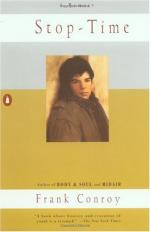|
This section contains 631 words (approx. 2 pages at 400 words per page) |

|
Stop-time Summary & Study Guide Description
Stop-time Summary & Study Guide includes comprehensive information and analysis to help you understand the book. This study guide contains the following sections:
This detailed literature summary also contains Topics for Discussion and a Free Quiz on Stop-time by Frank Conroy.
This autobiographical memoir recounts important incidents and circumstances in the author's life from the ages of nine through eighteen. It is, essentially, what is generally known as a "coming of age" story, a narrative in which a young person discovers important, necessary truths about the nature of being an adult - indeed, of simply being a human being. This is the narrative's primary theme, with secondary themes exploring the attraction and responsibilities of individual independence and the metaphorical nature of travel.
The memoir begins with a prologue set in the author's adulthood during his time in England. He describes his routine of sometimes interrupting his calm, ordered, productive, writerly life with drunken, almost dangerous road trips into London.
After the description of one such road trip, the author turns the face of his recollections towards his past - specifically, his childhood as the son of a man who spent much of his adult life in mental hospitals and the stepson of his mother's unfocused, undisciplined, and opportunistic boyfriend. The action shifts back and forth between the family's New York City apartment and the Florida wilderness where they construct a home. While in Florida, the author befriends another boy, Tobey, who for a while is his best friend but who, as narration later recounts, becomes essentially a stranger. The discovery of how people and once-close friendships change is, the narrative seems to suggest, an inescapable part of the "coming of age" process.
Important experiences in Florida include the author's youthful preoccupation or perhaps even obsession with becoming an expert manipulator of the yo-yo, and his burgeoning, almost simultaneous preoccupation with girls and sex. The relationship between the two, the childish game and the more adult interest in, among other sexual things, female anatomy is, in the book's apparent thematic perspective, another manifestation of the process of "coming of age".
Eventually, the author and his family settle in New York City, where the author coasts through school, where his step-father Jean engages in one get-rich-quick scheme after another, where his mother Dagmar becomes increasingly disillusioned with Jean, and where the author's adored baby sister Jessica is born. Also in New York, the author encounters a succession of colorful personalities, two of whom are tenants in the family's spare room - the nasty, manipulative Donald and the self-indulgent, neurotic Nell. Narration describes how Jean, who may or may not have had an actual affair with Nell, turns to Dagmar for help in getting her out of the house, help which Dagmar, who sees Nell as Jean's problem and responsibility, at first refuses to provide but then supplies ... at the cost of ongoing happiness with Jean.
Important experiences in New York, as the author continues to mature, include his growing disrespect for school and his discovery, at his first real job, that good humor, good relationships with fellow employees, and occasional bursts of work ethic are not enough to keep a job ... yet another step in the "coming of age" process.
After graduating high school, the author travels to Europe to continue his education. There he develops an intensely emotional relationship with the Swedish Christina, writes entrance exams for American universities, and loses the last of his illusions about his shallow, flighty, manipulative mother. Upon his return to America, he moves out of the family home in New York and away to a welcoming new life in university.
The book concludes with an epilogue in which the author describes the irony of a question posed by a bystander after a car accident from which the author walks away. That question is "What's all this?", a question which, in the context of the book in particular and of the genre of autobiography in general, can be seen as both probing and ironic.
Read more from the Study Guide
|
This section contains 631 words (approx. 2 pages at 400 words per page) |

|



